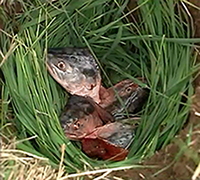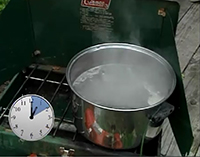Alaska Native Foods
Helping Hands: Keeping Your Family Safe
In this video, you’ll learn about what causes botulism, what its symptoms are like, who can get it, and how it’s treated. But, most importantly, you’ll learn how to keep your family safe from botulism.
Alaska has more foodborne botulism than any other state in the country. From 1950 to 2017, more than 350 people in Alaska have gotten botulism and 24 people have died.
People in Alaska have usually gotten botulism from eating traditional Alaska Native foods, such as:
- Fermented fish heads (“stinky heads”)
- Fermented fish eggs (“stinky eggs”)
- Fermented beaver tail
- Fermented seal flipper
- Fermented walrus flipper
- Fermented whale
- Seal oil
- Dried, unsalted fish
Botulism is a serious illness, but it can be treated. If you or someone you know has symptoms of botulism, seek medical care immediately.
Protect Your Family From Botulism

“Follow the traditional ways of preparing food. Don’t try to use any shortcuts to get them ready faster. Don’t use plastic containers.”
—Marie, botulism survivor
By following five food safety tips, you can protect yourself and your family from getting botulism when you prepare Native foods.
- Wash your hands, your containers, and your food before you start preparing your food.
By washing your hands with soap and water, you wash away germs that you get from touching a contaminated surface. Also, clean the containers and areas where food will be placed. Wash your food before preparing it. This reduces the germs, but does not remove all of them. These tips also will help prevent other diseases you can get from food. - Use traditional methods when you prepare Native foods.

Eating homemade fermented food has some risk of botulism. To reduce the chance of getting botulism, ferment food using the traditional method of a grass-lined hole in the ground. Use methods that allow air to circulate.
Do NOT use plastic or glass containers. They prevent air from circulating. Even a plastic or glass container without a lid may allow the botulism germ to grow in the bottom of the container.
It’s very important for fresh air to move around the fermenting foods, because botulism grows in an environment without air circulation – such as plastic or glass containers.
Use salt when drying fish. Salt is a natural preservative and reduces the chance that botulism poison will grow.
- Ferment food at a cold temperature.
Keep food cold by fermenting it in the ground and away from the sun. Ideally, the temperature of the food should be below 37°F. It might take longer to ferment the food, but it may be safer because if you keep food cold, you prevent botulism poison from developing. 
Boil fermented food before eating it.
Botulism poison is destroyed by high heat. Boiling fermented food for 10 minutes can destroy the botulism poison. It might change the taste from what you are used to, but it is one way to protect you and your family from botulism.If fermented foods are stored in plastic or glass containers before they are eaten, they also should be boiled, because the botulism poison cannot be seen, smelled, or tasted. Boiling will destroy botulism poison that is in the food.
- When in doubt, throw it out!
It is much better to throw out food that might be contaminated than to eat it and get sick or lose the life of a loved one. Be sure to throw out contaminated food where it cannot be eaten by children or pets.In addition, know how the food you eat is made. If you are not sure, then don’t eat it. Botulism poison is so strong that even a small taste can cause serious problems.
By following these simple tips, you can give a helping hand and keep your family safe from botulism.
Get more information about botulismexternal icon for the public and healthcare providers from the Alaska Department of Health and Social Services.
Contact us:
Arctic Investigations Program
Centers for Disease Control and Prevention (CDC)
4055 Tudor Centre Drive
Anchorage, Alaska 99508-5932
Phone: 907-729-3400
Email: ncidaip@cdc.gov
Alaska Department of Health and Social Servicesexternal icon
Division of Public Health, Section of Epidemiology
3601 C Street, Suite 540
Anchorage, Alaska 99503
Phone: 907-269-8000
Email: infdisease@alaska.gov